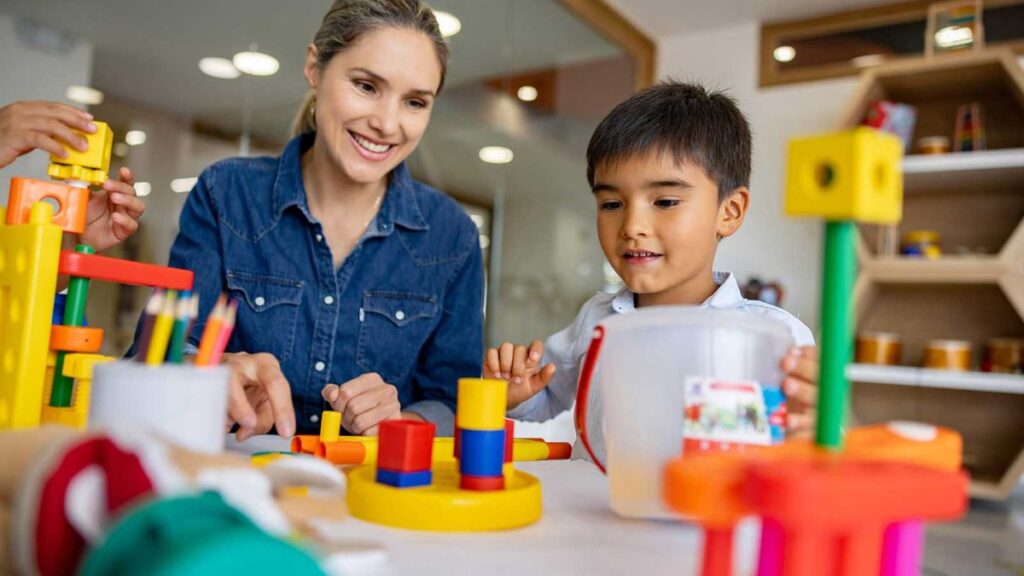Occupational therapy is a valuable support service that helps children develop important life skills, become more independent, and participate in daily activities. For families looking for developmental support, finding the right occupational therapist is crucial for their child’s growth and success.
When families start searching for “occupational therapy near me“, it marks the beginning of an important journey. This journey connects families with skilled professionals who understand their specific needs. Local occupational therapy services offer children the opportunity to thrive in familiar environments such as their homes and community spaces.
This guide aims to help families choose the right pediatric OT services by discussing:
- Important factors to consider when assessing potential providers
- Specific services available for children aged 6 months to 10 years
- Different funding options and coverage pathways
- Helpful tips for finding local practitioners
- Key questions to ask during consultations
- The significance of aligning therapists and families
With this information, families can make informed choices about their child’s occupational therapy journey. This ensures that they work with professionals who share their values and understand their goals.
Understanding Occupational Therapy and Its Benefits for Families
Occupational therapy empowers individuals to participate fully in daily activities through skilled intervention and support. For children, these ‘occupations’ include playing, learning, socialising, and developing essential life skills.
A paediatric occupational therapist focuses on supporting children’s development across multiple areas:
- Physical Development: Fine motor skills for writing and self-care, gross motor coordination for playground activities, core strength and postural control.
- Sensory Processing: Managing sensitivities to touch, sound, or movement, developing appropriate responses to sensory input, creating calming strategies for sensory regulation.
- Cognitive Skills: Problem-solving in daily routines, organisation and planning abilities, attention and focus during activities.
- Social-Emotional Growth: Building confidence through skill mastery, developing peer relationships, managing emotions and behaviour.
Occupational therapy creates meaningful changes in children’s lives through individualised support. A skilled occupational therapist helps children master essential skills while respecting their unique developmental journey. This therapeutic approach strengthens family relationships by providing parents with strategies to support their child’s development at home.
The benefits extend beyond individual therapy sessions. Children gain independence in daily routines, from dressing themselves to participating in school activities. Parents receive practical guidance for supporting their child’s development within natural family routines. This collaborative approach ensures sustainable progress that enhances the entire family’s quality of life.
Key Factors to Consider When Searching for ‘Occupational Therapy Near Me’
Selecting the right occupational therapist requires careful consideration of several essential factors to ensure optimal support for children and families.
Professional Qualifications and Expertise
When evaluating potential therapists, it’s important to verify their credentials and areas of expertise. Look for the following qualifications:
- Registration with the Australian Health Practitioner Regulation Agency (AHPRA)
- Specialised training in paediatric occupational therapy
- Experience working with specific conditions such as ASD, ADHD, and sensory processing differences
- Ongoing professional development and additional certifications
Holistic and Routine-Based Approaches
An effective occupational therapist understands that therapy extends beyond the clinic. They should incorporate strategies into the child’s daily life by:
- Assessing the child’s daily routines and environments
- Integrating therapy techniques into existing family schedules
- Recognising each child’s unique strengths and challenges
- Considering cultural and family values in treatment planning
Family-Centred Care
Occupational therapy is most successful when it involves the entire family. Look for services that prioritise:
- Active parent participation in goal setting and therapy sessions
- Regular communication about progress and strategies
- Practical guidance for implementing techniques at home
- Flexible scheduling options to accommodate family needs
Therapeutic Environment
The environment in which therapy takes place can greatly impact its effectiveness. Consider whether the therapist offers:
- In-home sessions for real-world skill development
- Community-based therapy in familiar settings
- Clinic-based services with specialised equipment
- A combination of environments based on individual needs
Communication Style
Effective communication between the therapist, child, and family is crucial for successful outcomes. Look for therapists who demonstrate:
- Clear explanation of assessment findings and treatment plans
- Regular progress updates and strategy sharing
- Respectful and supportive interactions with children
- Open dialogue with families about concerns and adjustments
Specialized Services Offered by Occupational Therapists for Children
Pediatric occupational therapy encompasses a range of specialised services designed to support children’s development and independence. These targeted interventions address unique challenges children face in their daily activities:
1. Sensory Integration Therapy
- Custom sensory experiences to help children process and respond to environmental stimuli
- Structured activities to build tolerance for different textures, sounds, and movements
- Sensory-based strategies for improved focus and emotional regulation
2. Fine Motor Skills Development
- Handwriting and drawing exercises
- Self-care activities like dressing and eating
- Play-based activities to strengthen hand muscles and coordination
3. Gross Motor Development
- Balance and coordination activities
- Core strength exercises through engaging play
- Movement planning and spatial awareness tasks
4. Positive Behaviour Support
- Individual strategies to manage challenging behaviours
- Environmental modifications to reduce triggers
- Skill-building activities to enhance social interactions
5. Daily Living Skills Enhancement
- Personalised routines for morning and bedtime
- Mealtime strategies for picky eaters
- Toilet training support and independence building
6. School Readiness Programs
- Classroom skills development
- Social interaction practice
- Academic task preparation
These specialised services create meaningful changes in children’s lives through:
- Enhanced participation in daily activities
- Improved confidence and independence
- Stronger social connections
- Better academic performance
- Reduced stress for families
Each child receives individualised support based on their specific needs, strengths, and family goals. Occupational therapists adapt these interventions to match the child’s developmental stage and interests, ensuring engagement and progress throughout the therapeutic journey.
In some cases, speech therapy services may also be integrated into the occupational therapy plan. This can significantly enhance a child’s ability to communicate and interact socially, further supporting their overall development.
Understanding Funding Options and Coverage for Occupational Therapy
Accessing occupational therapy services involves understanding various funding pathways available to Australian families. The National Disability Insurance Scheme (NDIS) stands as a primary funding source, providing comprehensive support for eligible participants. NDIS plans can cover:
- Individual therapy sessions
- Group therapy programmes
- Assessment and reporting
- Resource development
- Travel costs for therapy visits
Medicare Benefits Schedule
Through Medicare’s Chronic Disease Management plan, families can access up to 5 subsidised occupational therapy sessions per calendar year. A GP referral initiates this process, making therapy more accessible for families managing ongoing health conditions.
Private Health Insurance Options
Health funds offer varying levels of occupational therapy coverage:
- Basic policies: Limited annual session allowances
- Comprehensive policies: Higher rebates and session limits
- Gap payments: Variable depending on provider fees
- Waiting periods: Typically 2-12 months for therapy services
Self-Funded Arrangements
Private funding provides flexibility in service selection and frequency. Many occupational therapy providers offer:
- Payment plans
- Bulk billing options
- Sliding scale fees based on family circumstances
- Package discounts for multiple sessions
Early Childhood Early Intervention (ECEI)
Children under 7 years may access short-term early intervention funding through the NDIS ECEI pathway, supporting:
- Initial assessments
- Short-term therapy
- Family capacity building
- Connection to community services
Understanding these funding pathways helps families make informed decisions about accessing occupational therapy services. Local providers can assist in navigating these options and identifying suitable funding solutions for individual circumstances.

Finding Local Occupational Therapy Providers Near You
The search for local occupational therapy providers starts with understanding the available options across Greater Sydney. Each region offers distinct advantages:
Hills District
- Multiple established clinics with specialised paediatric services
- Strong community connections with local schools and childcare centres
- Mix of clinic-based and mobile therapy services
Hawkesbury Region
- Growing number of providers offering flexible service delivery
- Focus on rural and semi-rural community support
- Specialists in nature-based and outdoor therapy settings
North Shore
- Extensive network of experienced practitioners
- Advanced facilities and equipment
- Strong links to educational institutions
When researching local providers, consider these practical steps:
- Service Delivery OptionsIn-home therapy sessions
- Community-based support
- Clinic facilities
- School/childcare centre visits
- Location AccessibilityDistance from home/school
- Parking availability
- Public transport access
- Travel time considerations
- Specialised ServicesSensory integration expertise
- Early intervention programs
- Autism-specific support
- Motor skills development
Local directories and professional associations provide verified listings of registered occupational therapists. The Australian Health Practitioner Regulation Agency (AHPRA) register allows families to check practitioner credentials and registration status.
Parents benefit from visiting potential providers to assess:
- Facility equipment and resources
- Therapy room environments
- Staff interaction styles
- Scheduling flexibility
- Emergency protocols
- Communication systems
A provider’s ability to offer services in multiple settings creates opportunities for skill development across different environments. This flexibility supports children’s progress in familiar spaces where they naturally engage in daily activities.
The Importance of Community-Based and Real-Life Context Therapy
Community-based occupational therapy transforms everyday environments into powerful learning spaces. Children develop skills most effectively in the settings where they naturally spend time – their homes, schools, parks, and local community spaces. Click here to get how occupational therapy supports children with autism in castle hill.
Why Natural Environments Matter
Natural environments offer authentic opportunities for skill development:
- Home-based therapy allows children to practice daily routines like dressing, eating, and personal care in their familiar space
- School-based sessions support classroom participation, handwriting, and social interactions with peers
- Community settings build real-world skills through activities like shopping, crossing roads, or ordering food
This contextual approach creates meaningful learning experiences that directly translate to a child’s daily life. A child who practices balance at a local playground develops more practical skills than one who only practices in a clinical setting.
The Impact of Natural Learning
Research demonstrates that skills learned in natural environments transfer more readily to daily activities. When children master tasks in real-life situations, they:
- Build genuine confidence through authentic achievements
- Learn to adapt strategies across different settings
- Develop independence in familiar environments
- Form stronger connections with their community
The therapeutic value extends beyond the child to include family members and caregivers, who can observe and implement supportive strategies in their daily routines. This integrated approach ensures therapy becomes a natural part of everyday life rather than an isolated clinical experience.
Collaborative Approach Between Families, Educators, and Therapists
Successful occupational therapy thrives on strong partnerships between families, educators, and therapists. This collaborative approach creates a unified support network that reinforces therapeutic strategies across different environments.
Key Elements of Effective Collaboration:
- Regular Communication Channels: Shared progress updates, digital communication platforms, weekly therapy notes, and parent-educator meetings
- Skill Transfer Across Settings: Teaching strategies for home implementation, classroom accommodation recommendations, playground activity modifications, and lunchtime routine adaptations
A multidisciplinary team brings diverse expertise to support a child’s development. This team typically includes:
- Occupational therapists
- Speech pathologists
- Physiotherapists
- Educational staff
- Child psychologists
- Paediatricians
Each professional contributes unique insights and strategies, creating a comprehensive support system. Teachers provide classroom observations, therapists offer specialised interventions, and families share valuable insights about daily routines and challenges.
This integrated approach ensures consistency in therapeutic strategies. When a child learns new skills during OT sessions, these techniques transfer seamlessly to home and school environments. Parents receive practical guidance for implementing strategies during daily activities, while educators learn specific accommodations to support the child’s participation in class activities.
The collaborative model empowers families to actively participate in their child’s therapy journey. Parents develop skills to support their child’s development, while educators gain tools to create inclusive learning environments. This shared knowledge creates a strong foundation for sustained progress and meaningful outcomes.
Selecting an Occupational Therapy Provider That Aligns With Your Family’s Needs and Values
Finding an occupational therapy provider who shares your family’s values creates a strong foundation for successful therapeutic outcomes. A thoughtful evaluation of potential providers helps ensure meaningful connections and lasting progress.
Key Values to Consider:
- Inclusive Practices: Look for providers who celebrate diversity and adapt their approaches to honour each child’s unique characteristics
- Strengths-Based Philosophy: Select therapists who focus on building upon existing abilities rather than solely addressing challenges
- Family-Centred Care: Choose providers who respect family dynamics, cultural backgrounds, and individual preferences
Evaluating Therapeutic Approaches:
The therapist’s personality and communication style play vital roles in creating positive therapeutic relationships. Consider these aspects:
- Does the therapist actively listen and respond to family concerns?
- Are they flexible in adjusting strategies based on your child’s needs?
- Do they demonstrate genuine enthusiasm for working with children?
- Can they explain complex concepts in clear, accessible language?
Cultural Considerations:
A provider’s cultural awareness impacts the quality of care. Seek therapists who:
- Respect diverse family structures and traditions
- Incorporate culturally relevant activities into therapy sessions
- Provide resources and materials that reflect various cultural perspectives
- Demonstrate sensitivity to language preferences and communication styles

Questions to Ask When Interviewing Potential Occupational Therapists or Clinics
Preparing thoughtful questions helps families make informed decisions about occupational therapy services. Here’s a comprehensive list of essential questions to ask during initial consultations:
Experience and Expertise
- What experience do you have working with children who have similar needs to my child?
- How do you stay current with the latest therapeutic approaches and research?
- What specific training do you have in sensory integration, ASD, or ADHD support?
Session Structure and Settings
- What does a typical therapy session look like?
- Do you offer services in different environments (home, school, clinic)?
- How long are therapy sessions, and how often do you recommend them?
Family Involvement and Communication
- How do you involve parents/carers in therapy sessions?
- What methods do you use to track and share progress?
- How do you communicate with other professionals in my child’s support team?
Practical Considerations
- What are your availability and scheduling options?
- How do you handle cancelled appointments?
- What support do you provide for funding applications and documentation?
Therapeutic Approach
- How do you develop individualised therapy goals?
- What strategies do you use to keep children engaged during sessions?
- How do you adapt your approach if initial strategies aren’t effective?
These questions create a foundation for open dialogue between families and potential therapists, helping to establish whether their approach aligns with the family’s needs and expectations.
Conclusion
Choosing the right occupational therapy provider is crucial for a family’s therapeutic journey. It’s not just about looking at qualifications and experience – it’s also about finding professionals who truly understand each family’s unique dynamics and goals.
By taking the time to research local occupational therapy services in Sydney, parents can create opportunities for meaningful connections. Here are some ways parents can benefit from this approach:
- Visit multiple providers
- Ask detailed questions
- Observe therapist interactions
- Listen to their intuition
The ideal occupational therapy partnership happens when families find professionals who share their values while also providing expert support. This strong foundation allows children to thrive in an environment filled with understanding, respect, and collaborative care.
Trust the process of finding the right match – there is a perfect occupational therapy provider out there for every family. By carefully considering the factors discussed in this article, parents can make informed choices that have a positive impact on their child’s development and the overall wellbeing of the entire family.

